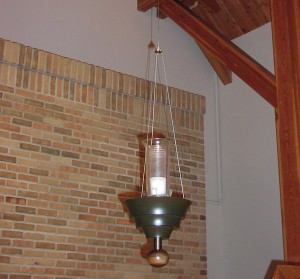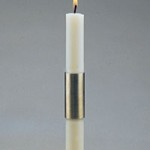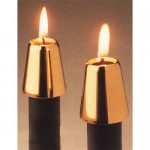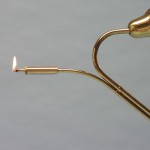 The name candle comes from the Latin candere meaning “to shine.” While no date can be definitely pinned down for the development of the first candle, we do know that candles were developed independently in many countries.
The name candle comes from the Latin candere meaning “to shine.” While no date can be definitely pinned down for the development of the first candle, we do know that candles were developed independently in many countries.
Accounts of candle use date back to ancient times with Biblical references as early as the 10th century BC. The Egyptians and Cretans made candles from beeswax as early as 3000 BC. The Chinese created candles from whale fat during the Qin Dynasty (221-206 BC). In early China and Japan tapers were made with wax from insects and seeds wrapped in rice paper. Yak butter was used for candles in Tibet and in India wax was made from boiling the fruit of the cinnamon tree.
During the Middle Ages, candles became associated with worship. Priests made beeswax candles for their services and also for the general public. Using the Roman method, they simply poured melted beeswax over a wick.
Tallow from cows and sheep became the standard material used in candles in Europe. However the candles had a very unpleasant smell due to the glycerin content. In fact, it was so bad that several towns banned their use by ordinance. This is why candles made from beeswax were used for church and royal events. Beeswax candles were a marked improvement but were expensive, so only the church or the wealthy could afford them.
 The early candles in America were made by suspending wicks in a mold and pouring liquid tallow three times and then hanging on a rack to dry. After this first dipping, the candles would be dipped repeatedly until they were thick enough. Colonial women in America offered a first in candle making by boiling the berries of bayberry bushes that produced a sweet smelling wax that burned clean. It was a tedious task and the popularity soon faded, as it required 1 and ½ quarts of berries to make an 8-inch taper.
The early candles in America were made by suspending wicks in a mold and pouring liquid tallow three times and then hanging on a rack to dry. After this first dipping, the candles would be dipped repeatedly until they were thick enough. Colonial women in America offered a first in candle making by boiling the berries of bayberry bushes that produced a sweet smelling wax that burned clean. It was a tedious task and the popularity soon faded, as it required 1 and ½ quarts of berries to make an 8-inch taper.
The whaling industry brought the first major change in candle making in the late 18th century with spermaceti, a wax obtained by crystallizing sperm whale oil. Like beeswax it did not smell bad and actually was found to be harder than tallow and beeswax. During this time the whaling industry boomed, but we all know that using whale oil has had dire consequences on the whale population.
Around this time cotton and linen came into the market and both were used for wicks. By braiding several strands together, which produced a tight plait, the wick would curl over and burn.
The 19th century was a defining time for candles and candle making. The first patented candle making machines were introduced. Michael Chevreul identified stearic acid for the first time as one of various fatty acids in tallow or animal fat. Stearic acid became and still is today a vital part of the candle industry.
Candles are often used as a sign of festivity and solemnity in Christian worship. The use of such lights has a long and varied tradition. Acts:20 records that there were “many lights” at the service at Troas when Paul and other Christians gathered to break bread. Lamps and candles were in normal use in Christian worship by the 4th century, but for many years it was not customary to place candles on the altar. The first known mention of the use of altar lights was a 12th century report that two candles flanked an altar cross in the papal chapel. The injunction of Edward VI in 1547 called for there to be two lights on the high altar “for the signification that Christ is the very true light of the world.” Candles have been used in some English cathedrals and churches since the 17th century. The use of candles at the Eucharist was disputed in the Church of England and in the Episcopal Church during the 19th Century. During the years of ritualist controversy in the Episcopal Church, the General Conventions of 1868, 1871 and 1874 all considered proposals to prohibit the use of altar candles but nothing was ever passed.
The BCP now provides certain times that candles play a significant part in the service:
The Easter Vigil begins with the lighting of the Paschal Candle, the altar candles are lighted after the Renewal of Baptism Vows and before the Easter Acclamation, “Alleluia, Christ is Risen.” Candles are lighted after the dedication of the altar by the bishop at the Consecration of a Church. At the order of Worship for the Evening, the lighting of the altar candles and other candles follows the Prayer for Light and precedes the hymn “O Gracious Light.”
Advent wreath — An advent wreath is a circle of greenery with four candles of color, which may be purple or Sarum blue, and rose. The candles are lighted in succession each Sunday in Advent. A white candle in the center, called the Christ Candle is lighted on Christmas Eve.
Candelabra may have different numbers of branches, usually three, five, or seven and may be placed on the re table flanking the altar cross.
Single candles sticks may be placed on the re table or on the altar. If placed on the altar it is customary to light them at the beginning of the Great Thanksgiving and to extinguish them at the conclusion. This is an optional practice that is decided by the Rector or the Vicar.
 A sanctuary lamp or light is a light that burns near the Aumbry when it contains Reserved Sacrament.
A sanctuary lamp or light is a light that burns near the Aumbry when it contains Reserved Sacrament.
Torches are candles on poles that are carried in the processional and used to flank the reading of the Gospel.
A votive light is a small candle often used at the Festival of Lessons and Carols and at the Feast of the Epiphany service on January 6, celebrating the coming of the Magi.
Paschal Candle — The origin of the oversized Paschal Candle is uncertain and its use has varied as well. Initially it was broken up after the Easter Vigil and its fragments given to the faithful. This practice was later transferred to the following Sunday. In the 10th century it was kept in a place of honor near the Gospel until the feast of the Ascension.
Around the 12th century the custom began of inscribing the current year on the candle as well as the dates of the movable feasts. The candle grew in size and in some cases weighed 300 lbs. Today’s smaller size is more suitable for carrying to the altar in procession at the Easter Vigil. After the Easter season, it is typically placed near the font. It should burn at baptisms, representing the new life in Christ that we share in baptism. It may also be carried in procession at burials and placed near the coffin as a symbol of resurrection life.
Pavement Lights are candles in long holders or poles in stands that rest on the floor of the church. They may be placed near the altar and lighted during services.
Beeswax candles are expensive but at the same time are economical as they burns slowly, are odorless, dripless, and smokeless. and emit beneficial ions, which remove toxins (this process cleans the air of dust, odors, pollen, mold, dust mites, etc).
Beeswax/Stearine candles are most used by churches. They are less expensive than pure beeswax although they burn faster.
Stearine candles, based on animal or vegetable oil, are least expensive. Paraffin candles are not recommended because they are made from petroleum sludge, highly refined and treated with carcinogenic chemicals. The black smoke that a paraffin candle emits is basically diesel exhaust and as it is oil instead of water based, it is harder to clean up. (EPA warns of the health hazards of burning paraffin candles.) Soy candles, made from American grown soybeans, last 50% longer than petroleum based (paraffin) candles and are biodegradable. They burn slower than petroleum based candles, are cooler, non-toxic, and produce very little soot.
The purpose of a wick is to deliver fuel (wax) to the flame. The wick draws the liquefied wax up into the flame to burn. Too much and it will flare and soot, too little and the flame will sputter out. Wicks consist of a bundle of fibers that are twisted, braided, or knitted together. The type of wax used in a candle determines the type of wick.
Candle Accessories:
 Brass candle JOINERS, available at most sacristy supply houses, make it possible to create new candles by joining two half-used candles. A tricky job!
Brass candle JOINERS, available at most sacristy supply houses, make it possible to create new candles by joining two half-used candles. A tricky job!
 Brass or glass candle FOLLOWERS should be placed on altar candles to ensure even burning. Once placed on a candle, a follower should not be removed until the candle is ready for disposing. It is important for followers to be cleaned between uses either placing them in boiling water or in a freezer for easy removal of wax.
Brass or glass candle FOLLOWERS should be placed on altar candles to ensure even burning. Once placed on a candle, a follower should not be removed until the candle is ready for disposing. It is important for followers to be cleaned between uses either placing them in boiling water or in a freezer for easy removal of wax.
SNUFFERS/LIGHTERS also need to be cleaned after each service and tapers trimmed. Extend a taper one inch before lighting and trim after extinguishing. Offer to give a lesson in lighting and snuffing to the acolytes! Moving the snuffer too fast after extinguishing the flame will cause wax to drip. Pieces of wick (if it has not been trimmed to ¼ inch) can fall and burn linens.
A fairly new adapter for the lighter has been developed and marketed by Almy. It is an oil filled case with a fiberglass wick that is attached to your lighter after all of the taper has been removed. The container holds enough oil to light candles for three or more services. The wick does not burn but feeds the oil for a flame thus needs no trimming. We have been delighted with results, as we no longer encounter dropped wax on the Fair Linen. The only drawback is that it is oil from paraffin, which is petroleum based.
A Few Handy Tips:
Always use a follower on altar candles. To seat, place it on the shoulder of the candle and give it a ¼ inch turn. Straighten the wick and precondition the candle by burning for at least two minutes.
Extend the lighting taper one inch out before lighting. Handle the lighter carefully to avoid pieces of the taper or wick from breaking off. After snuffing the candles and retracting the taper in the lighter tube. Immediately extend the taper out from the tube to avoid wax build up and jamming. Never allow the snuffer to rest on the follower when extinguishing the flame as the follower is resting on both liquid and soft wax. Watch for drafts from open doors, heat/ac vents, etc. as they cause an unsteady flame.
Trim the wick of any candle to ¼ inch every time you light the candle. Always use a snuffer to extinguish a candle. No BLOWING. The snuffer helps prevent wax sprays and keeps the wick centered.
by May Sherrod
